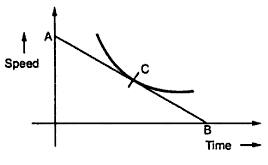Retardation Test or Running Down on D.C Machines
In this article, we are going to discuss retardation test on dc machines.Retardation test is also called as running down test.This is the very efficient way to find out stray losses in dc shunt motors.In this test, we get total stray losses nothing but the combination of mechanical (friction & windage) and iron losses of the machine.
The circuit diagram of retardation test on dc machines shown below. A1, A2 are armature terminals.

The procedure of Retardation Test on D.C Machines
The main points in the retardation or running down test are discussed below,
1. Now start the dc machine normally, run the machine slightly above the rated speed by adjusting resistance.
2. After achieving the rated speed just cut off the power supply to the armature, but keeping field normally excited.
3. Now wait for some time to fall down of speed below rated, then using the tachometer note down the values of speed (in rpm) and time (in the sec).
4. The armature consequently slows down and the amount of kinetic energy present in the armature is used to supply the rotational or stray losses which include iron, friction and winding loss.
2. After achieving the rated speed just cut off the power supply to the armature, but keeping field normally excited.
3. Now wait for some time to fall down of speed below rated, then using the tachometer note down the values of speed (in rpm) and time (in the sec).
4. The armature consequently slows down and the amount of kinetic energy present in the armature is used to supply the rotational or stray losses which include iron, friction and winding loss.
If I am the amount of inertia of the armature and is the angular velocity.
The kinetic energy of armature = 0.5 Iω².
Rotational losses, W = Rate of change of kinetic energy.

I=Moment of inertia of the armature.
In retardation test of dc machines, the rotational losses are given by
We have the formula for stray losses in retardation test of machines, but here the moment of inertia (I) of the armature is unknown.To find out we have two different methods.We need to find dN/dt too.
Determination of dN/dt in retardation test of dc machines
The voltmeter (V1) across the armature will give the value of back e.m.f. of the motor. We know that back e.m.f. is proportional to speed so that we calibrate the voltmeter to show the speed reading directly.

When the motor is cut off from the supply, the speed decrease in speed is noted with the help of stopwatch.You can observe curve drawn between calibrated values of time and speed.
At any point C corresponding to normal speed, a tangent AB is drawn. Then the value obtained from below can be substituted in the expression for W which can give the rotational losses.
dN/dt=OA(in rpm)/OB(in seconds)
Methods of finding the moment of inertia (I) in retardation test
(a) Using Flywheel
(b) Without using Flywheel
(a) Using Flywheel in retardation test
In this method, we use the flywheel whose moment of inertia is I1 to find the I value. In the first case, retardation test is performed with armature alone and dN/dt1 is determined. In next case, the flywheel is employed on the shaft, change in speed, dN/dt2 is noted.Addition of fly-wheel will not materially affect the rotational losses.
Since the values of I1, t1 and t2 are known, the moment of inertia I of the
armature can be determined.
(b) Without using Flywheel in retardation test
Without using the flywheel, I am eliminated from the expression by an experiment. First, retardation test is performed by armature alone. The rotational losses are given by;
W = 0.011 IN dN/dt1
Next, the motor is loaded with a known amount of power W’ with a break. For
the same change in speed, dN/dt2 is noted. Then,
Since the values of W’, t1 and t2 are known, the value of W can be determined.
The electric loading in retardation test W’ (or extra power loss) is given by;
W’ = average voltage x average current = V’ I’a.
This is the simple article on retardation test on dc machine.